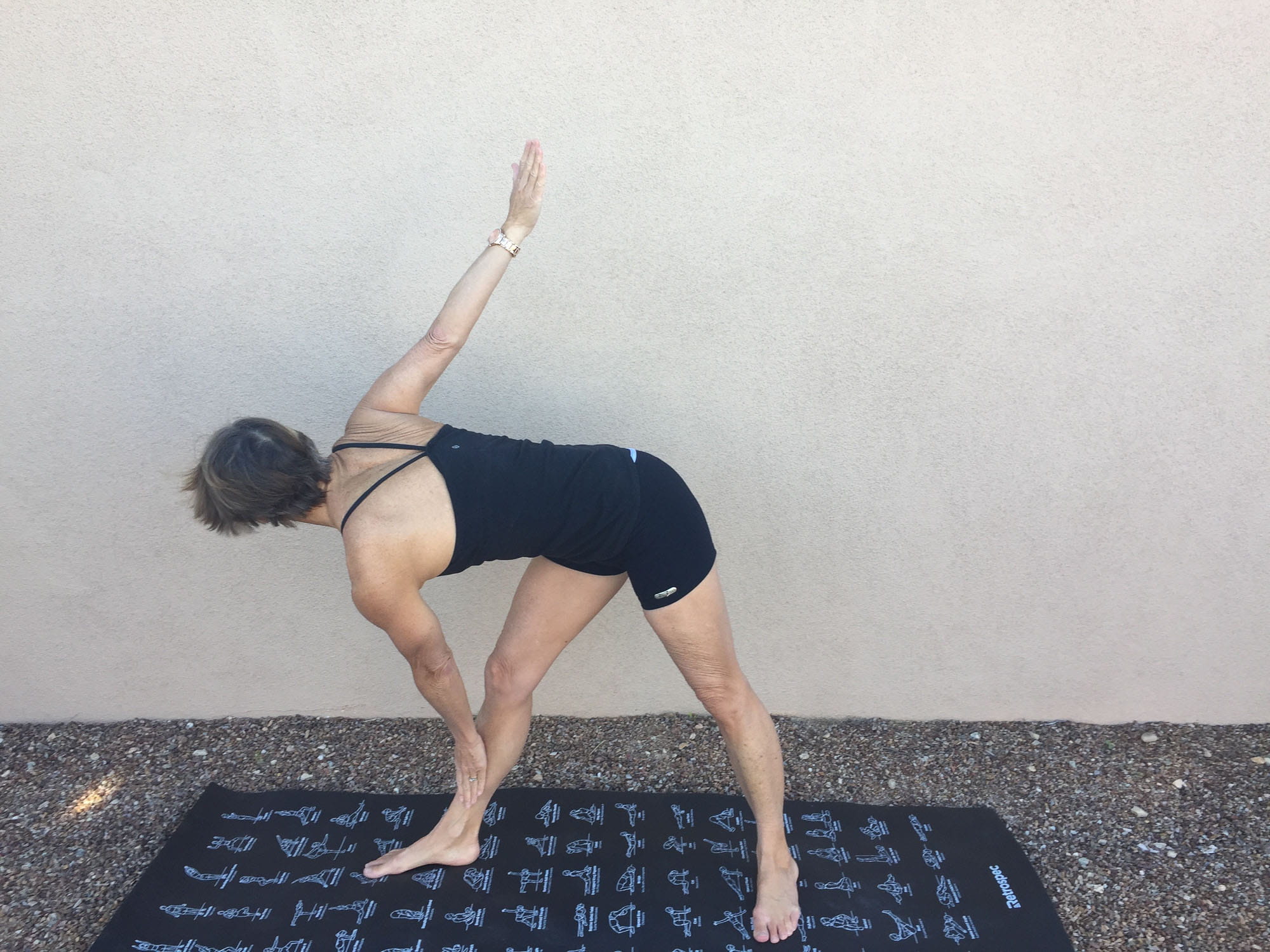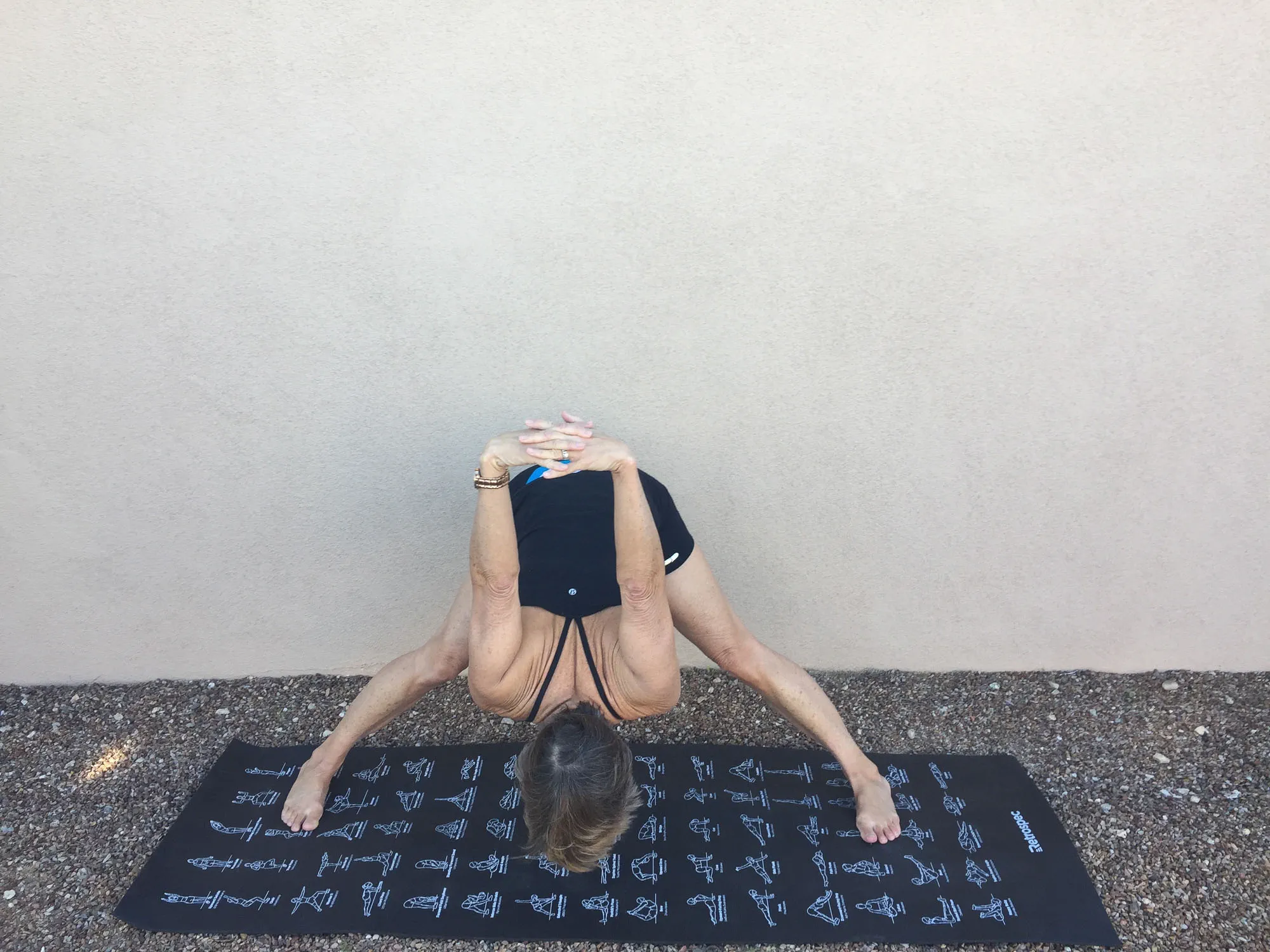A Yoga Practice to Make You Sweat
Use this intense Vinyasa flow practice to sweat your way back to calm
There’s nothing like an intense Masters swimming workout to release frustrations and worry. But now that most of us no longer have a place to swim and those dreaded 400 IM sets have become an almost distant memory, finding an outlet for the stress we’re facing with this pandemic is difficult.
This intense vinyasa yoga flow practice will get your heart pumping, make you sweat, and help you feel more like yourself again. Some of you may also enjoy David Swenson’s Ashtanga First series video on YouTube, which is very intense and can be modified as needed.
Stand at the front of your mat with your feet together or about hip-width apart. Place your palms together, close your eyes and take some slow, deep breaths, drawing inward and letting go of outside distractions. Take this time if you desire to set an intention for your practice.
Now take a deep inhale through your nose and sigh as you exhale through your mouth, imagining you are fogging up a mirror. Do this breathing pattern two more times and then close your mouth and see if you can continue to make that same fogging-up-the-mirror or ocean-breath sound as you exhale. Now see if you can make that sound when you inhale and exhale. This is called Ujjayi, or victorious breath, and brings heat into your body to facilitate loose and flexible tissues. Maintain this style of breath throughout your practice unless you find it uncomfortable.
Sun Salutation A (Surya Namaskara A)
- Inhale, raising both arms overhead, bringing your hands together and gazing at your thumbs.
- Exhale and fold forward, reaching for your lower legs or feet and gazing at your toes. Keep knees slightly bent if you feel any pressure in your lower back.
- Inhale, lifting your torso slightly, raising your gaze, and lengthening your spine.
- Exhale step or jump back into plank position (or kneeling plank) and lower down into chaturanga, hugging the body with your elbows while gazing forward. You can hover one inch from the floor or lower your torso all the way down.
- Inhale, straighten your arms, roll up on top of your feet, toes pointed, raise your gaze and lift up into upward dog. You can modify steps 4 and 5 by doing a kneeling plank to chaturanga and then doing a low cobra (small lift of the torso which results in minimal compression of lumbar vertebrae) instead of an upward dog.
- Exhale as you curl your toes under and raise your hips to the sky in downward-facing dog. Lengthen your spine from the sacrum to the crown of your head. Stay here for five long deep breaths.
- Inhale as you jump or walk your feet forward. Lengthen your spine and raise your gaze.
- Exhale fold forward, gazing at your toes.
- Inhale, bending knees slightly and raising your arms high over your head until your palms touch. Gaze at your thumbs.
- Exhale and lower your arms alongside the body in Samasthiti in preparation for the next Sun Salutation. Perform this series three to five times.
Sun Salutation B (Surya Namaskara B)
- Inhale as you sink down into chair pose, raising both of your arms overhead and gazing upward toward your thumbs. Keep your weight in your heels, push hips back, and make sure your toes are visible in front.
- Exhale, fold forward drawing your chest toward your knees and reaching for your feet or lower legs.
- Inhale, raise your gaze and your torso, lengthening your spine.
- Exhale and step or jump back to plank position (or kneeling plank). Perform your chaturanga with gaze raised slightly.
- Inhale into your upward dog (or low cobra).
- Exhale and raise your hips into downward-facing dog.
- Inhale as you step forward with the right foot, allowing your left foot to turn out about 45 degrees. Raise your arms overhead, palms facing toward each other, gazing at your thumbs in warrior A.
- Exhale as you place your hands on the floor, step the right foot back and come into plank and perform a chaturanga.
- Inhale into upward dog.
- Exhale into downward-facing dog.
- Inhale as you step forward with the left foot, allowing your right foot to turn out about 45 degrees. Raise your arms overhead, palms facing toward each other gazing at your thumbs in warrior A.
- Exhale as you place your hands on the floor and step your left foot back, coming into plank position and then lowering your chest toward the mat in chaturanga.
- Inhale into upward dog.
- Exhale into downward-facing dog. Stay here for five deep breaths.
- Inhale, jump or walk the feet toward the hands. Lengthen your spine as you raise your gaze.
- Exhale fold forward, lowering your chest toward your knees and your gaze toward your toes.
- Inhale bend your knees, sitting back in chair pose as you raise your arms overhead and gaze at your thumbs.
- Exhale and float your arms down alongside your body in Samasthiti. Perform the Sun Salutation B sequence three to five times.
Plank/Downward Dog/Lunge Sequence
- Inhale, raising both arms overhead, bringing your hands together and gazing at your thumbs.
- Exhale and fold forward, reaching for the lower legs or feet and gazing at your toes.
- Inhale, lifting torso slightly, raising your gaze, and lengthening your spine.
- Exhale and step or jump back into plank. Inhale.
- Exhale into downward-facing dog.
- Inhale step forward with the right foot, keeping the left heel up off the mat, transitioning into lunge.
- Exhale place hands on either side of the foot.
- Inhale step back into plank.
- Exhale back to downward dog.
- Inhale step forward with the right foot, keeping the right heel up off the mat, transitioning into lunge. Repeat steps 4 to 10 three to five times (PlankDDLunge.m4v).
- From downward dog, transition to the next phase of the practice.
- Inhale as you jump or walk your feet forward. Lengthen your spine and raise your gaze.
- Exhale fold forward, gazing at your toes.
- Inhale, bending knees slightly and raising your arms high over the head until your palms touch. Gaze at your thumbs.
- Exhale and lower your arms alongside the body in Samasthiti.
Extended Triangle (Utthita Trikonasana)
Step your left foot back, turning it outward about forty-five degrees. Right foot is pointing straight to the front. Straighten your legs. Inhale and raise your arms out to sides like tree branches, tip toward your front leg and rotate your body, spiraling upward so your left hand reaches for the sky and your right hand reaches toward the inside of the lower leg or right foot. Pause at a position where you can keep your shoulders stacked. Spread the space between your shoulder blades. Stay here for five deep breaths.
Revolved Triangle (Parivritta Trikonasana)
Windmill your arms downward and bring your left hand on the inside of the lower right leg or ankle and then reach your right arm up toward the sky. Lengthen your upper postural muscles, staying particularly long through the neck. Stay here for five deep breaths.
Step to the front and do the extended and revolved triangle with your right foot back (holding each pose for five breaths) and then return to the front of the mat with the feet side by side. You have the option of doing a vinyasa (same as Sun Salutation A but only staying in the downward-facing dog for one breath) before moving on to the next pose.
Side Angle Pose (Utthita Parsvakonasana)
Inhale and step your left foot back, turning this foot out at about a forty-five-degree angle toward the front. Extend your arms like tree branches. Lunge forward, bending the right leg until the knee is stacked over your right ankle. Perch your right forearm on the right thigh, without dumping too much weight into it (so space between shoulder and ear is maintained). Spiral the left side of your body upward, extending your left arm over the head and beyond so that a strong stretch is felt in the left side body from the triceps to your waist. Ground in all four corners of each foot. Hold the pose for five deep breaths.
Revolved Side Angle Pose (Parivritta Parsvakonasana)
Inhale, raising your torso and coming out of side angle pose. Place your palms together and rotate toward the right, possibly resting your left elbow on your right thigh and pressing the palms toward the center of your chest. Feel grounded and rooted in all four corners of the feet. Stay here for five deep breaths.
Now step your left foot forward and do side angle and revolved side angle poses with the left foot in front. Hold each pose for five breaths. Then step to the front of the mat. You have the option of doing a vinyasa before going onto the next pose.
Wide Stance Intense Stretch Posture (Prasarita Padottanasana A)
Inhale and jump or step a quarter turn to your right. Position your feet in a nice wide stance so you feel comfortable lengthening in your inner thighs. Turn your toes so your feet are pointing straight ahead toward the side of the mat. Inhale and place your hands on your waist. Exhale and hinge forward, placing your hands about shoulder-width apart on the floor or on a block, fingers along the same line as your toes. Think about opening your chest and lengthening from your sacrum to the crown of your head as you tip forward. Avoid hunching in the upper back or dropping your head forward. Keep your legs active to create a balanced foundation for the pose. Distribute weight evenly across the bottom of your feet and avoid gripping with your toes. If discomfort is felt in the back of your knees, this can be alleviated by bending your knees slightly. Stay here for five deep breaths.
Wide Stance Intense Stretch Posture (Prasarita Padottanasana C)
Inhale and slowly return to upright. Interlace the fingers behind your back (or press palms toward each other) and open the sides of the shoulders by squeezing your shoulder blades together. Exhale as you slowly hinge at the hips, tipping the torso and the clasped arms forward, lengthening through your spine. Think about opening your chest and lengthening from your sacrum to the crown of your head as you tip forward. Avoid hunching in the upper back or dropping your head forward. Keep your legs active to create a balanced foundation for the pose. Distribute weight evenly across the bottom of your feet and avoid gripping with your toes. If discomfort is felt in the back of your knees, this can be alleviated by bending your knees a bit.
Inhale, slowly come back up and exhale release the hands, turn your feet back toward the front and jump or step back to the front of the mat.
Chair Pose (Utkatasana)
Start in mountain pose with your feet touching or slightly apart, toes tracking straight ahead. Lift and spread your toes. Once you feel rooted to the ground on all four corners of both feet, slowly sit back as if there is an invisible chair behind you, bringing your thighs as close to parallel to the floor as possible. Raise your arms up, palms facing in and roll the shoulders down and away from your ears. Direct your gaze toward your hands. Keep weight concentrated in your heels and knees tracking over your toes. Toes should still be visible in front of the knees. Use your hamstring muscles to draw your sit bones forward. This will keep you from arching your back. Stay in this posture for five deep breaths.
Warrior Posture (Virabhadrasana A)
Step back with the left foot, transitioning into Virabhadrasana A, right leg bent so knee is stacked over ankle and right foot points straight ahead, and your left foot is turned out at about 45 degrees. Raise your arms over head and lengthen through your spine and ground in all four corners of both feet, being particularly mindful to press the outer edge of the left foot into the floor. Keep your pelvis aligned toward the front of your mat and stay elevated in the upper postural muscles. Gaze up at your thumbs or slightly upward and stay here for five deep breaths.
Warrior Posture (Virabhadrasana B)
Transition into Virabhadrasana B, pivoting your left toe straight out to the side and extending your arms out like tree branches, parallel to the floor. Maintain the 90-degree bend of the front leg, ensuring your knee does not project past your ankle. Gaze toward your right middle finger. Stack your shoulders over your hips and tuck your pelvis slightly under to reduce pressure on your lower back. Root with all four corners of both feet, feeling very grounded to the earth.
Reverse Warrior (Utkatasana)
Allow your hands to float down and then reverse the warrior, maintaining the 90-degree angle on the front leg, resting the left hand on the back of your left thigh and reaching upward and back toward the left leg with your right arm so your biceps are near your right ear and a right side-body stretch is felt. Stay here for five deep breaths. Inhale, relax your arms alongside your body, and then exhale and step to the front of your mat. Repeat the three warrior poses, this time stepping back with the right foot and having a left foot lead.
Finish
Perform a vinyasa and transition to a seated position from downward-facing dog. Finish your practice with some seated and/or supine postures and then end by listening to a relaxing Yoga Nidra routine of your choice on the Insight Timer App.
Categories:
- Technique and Training
SIGN UP FOR UPDATES FROM USMS



























